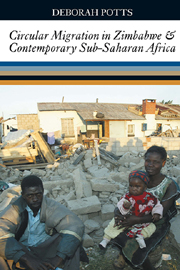Book contents
- Frontmatter
- Contents
- List of Maps, Figures, Tables, Boxes & Photographs
- List of Abbreviations
- Preface
- 1 Introduction
- 2 Regional Paradigms & Approaches to Circular Migration
- 3 Regional Paradigms & Approaches to Circular Migration
- 4 Harare & Zimbabwe
- 5 Migrant Livelihoods & Migration Trajectories in Harare
- 6 Harare Migrants' Rural Links & Assets
- 7 Variations in Migrants' Experience, Perceptions & Options
- 8 Social & CulturalAttachments to Rural Settings & Homes
- 9 Attacking the Urban Poor & Abusing Rural Links Operation Murambatsvina 2005
- 10 Conclusion
- Appendix: Consumer Price Index (all items) for Urban Families 1973–2007
- Bibliography
- Index
8 - Social & CulturalAttachments to Rural Settings & Homes
Published online by Cambridge University Press: 05 July 2013
- Frontmatter
- Contents
- List of Maps, Figures, Tables, Boxes & Photographs
- List of Abbreviations
- Preface
- 1 Introduction
- 2 Regional Paradigms & Approaches to Circular Migration
- 3 Regional Paradigms & Approaches to Circular Migration
- 4 Harare & Zimbabwe
- 5 Migrant Livelihoods & Migration Trajectories in Harare
- 6 Harare Migrants' Rural Links & Assets
- 7 Variations in Migrants' Experience, Perceptions & Options
- 8 Social & CulturalAttachments to Rural Settings & Homes
- 9 Attacking the Urban Poor & Abusing Rural Links Operation Murambatsvina 2005
- 10 Conclusion
- Appendix: Consumer Price Index (all items) for Urban Families 1973–2007
- Bibliography
- Index
Summary
Rural–urban linkages and circular migration are influenced by both economic needs and by social and cultural factors. The balance of these forces is often hard to disentangle for individual households, let alone for a whole city or region. Furthermore, the relative importance of these influences is contested in the academic literature. Not surprisingly, studies by anthropologists of these phenomena frequently stress the significance of culture, kinship and networks while those by economists or geographers often find more explanatory power in income and economic livelihood factors. It has already been noted in Chapter 2 that studies in West African settings find more salience in the social and cultural drivers of continuing circulation and links to rural settings than studies in southern Africa. It is believed that this not only reflects a difference in the regional paradigms within which such work is conducted, but also some real differences in the phenomena in these regions which can be ascribed to a range of differentiating factors, such as different contemporary rural settlement and agricultural geographies, different urban histories, and marked variation in the ways in which pre-colonial political institutions were affected by their incorporation into European colonial power structures.
- Type
- Chapter
- Information
- Publisher: Boydell & BrewerPrint publication year: 2010

